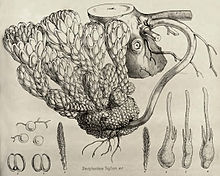Wood rose (New Zealand)
| Dactylanthus taylorii | |
|---|---|
 |
|
| Scientific classification | |
| Kingdom: | Plantae |
| (unranked): | Angiosperms |
| (unranked): | Eudicots |
| (unranked): | Core eudicots |
| Order: | Santalales |
| Family: | Balanophoraceae |
| Genus: |
Dactylanthus Hook.f. |
| Species: | D. taylorii |
| Binomial name | |
|
Dactylanthus taylorii Hook.f. |
|
Dactylanthus taylorii, commonly known as wood rose, is a fully parasitic flowering plant, the only one endemic to New Zealand. The host tree responds to the presence of Dactylanthus by forming a burl-like structure that resembles a fluted wooden rose (hence the common name). When the flowers emerge on the forest floor, they are pollinated by a ground-foraging species of native bat.
Dactylanthus taylorii is a round warty tuber-like stem (up to 50 cm wide) or haustorium with no roots, which draws nutrients from the roots of its host. Its leaves do not photosynthesise, and are reduced to floral bracts. Some plants have been aged in excess of 30 years old.Dactylanthus prefers damp but not waterlogged soil, and is often found at the head of small streams. It parasitises about 30 species of native hardwood trees and shrubs, preferring those growing in secondary forest on the margin of mature podocarp forest. Common hosts include pate or seven-finger (Schefflera digitata), five-finger (Pseudopanax arboreus), lemonwood (Pittosporum eugenioides), and putaputaweta (Carpodetus serratus).
Plants are either male or female. They flower between February and May and are primarily pollinated by the native short-tailed bat. Analysis of fossil coprolites suggest the kakapo (Strigops habroptilus), a flightless nocturnal parrot, was also a pollinator. Pollinated plants produce fruits slightly under 2 mm (0.079 in) long. The nectar exudes a musky smell that resembles mammalian sweat. Introduced mice and rats also pollinate them, although rats tend to destroy them.
...
Wikipedia

